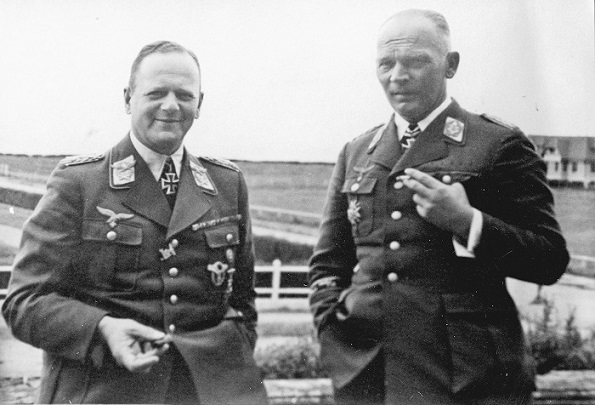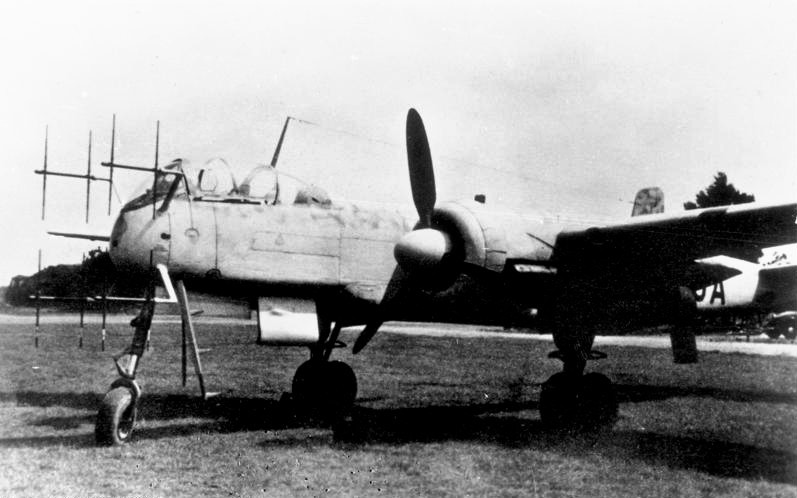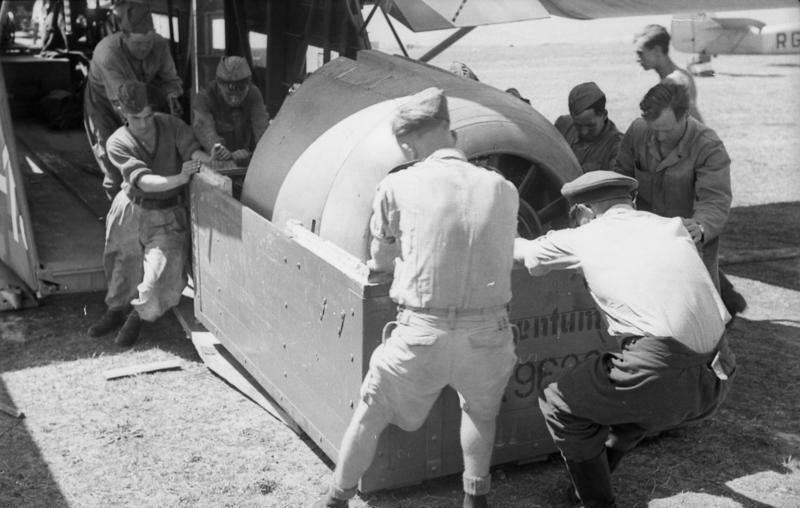|
Heinkel He 274
The Heinkel He 274 was a German heavy bomber design developed during World War II, purpose-designed for high-altitude bombing with pressurized crew accommodation. Due to the Allied advance through Northwest Europe, the prototypes were abandoned at the French factory where they were being built. They were completed after the war by the French and used for high-altitude research. Background On 17 November 1938, the owner of the Heinkel aviation firm, Ernst Heinkel, requested permission from the RLM that two of the requested eight prototype airframes for the nascent He 177 heavy bomber project, specifically the V3 and V4 airframes, be set aside for a trial installation of four separate Junkers Jumo 211 powerplants.Griehl & Dressel 1998, p. 14 Heinkel had foreseen that an individually engined version of his bomber would someday be preferred, quite unlike the requested fitment of the coupled pairs of Daimler-Benz DB 601 inverted V12 engines, each known as a DB 606 — weigh ... [...More Info...] [...Related Items...] OR: [Wikipedia] [Google] [Baidu] |
Heavy Bomber
Heavy bombers are bomber aircraft capable of delivering the largest payload of air-to-ground weaponry (usually bombs) and longest range (takeoff to landing) of their era. Archetypal heavy bombers have therefore usually been among the largest and most powerful military aircraft at any point in time. In the second half of the 20th century, heavy bombers were largely superseded by strategic bombers, which were often smaller in size, but had much longer ranges and were capable of delivering nuclear bombs. Because of advances in aircraft design and engineering — especially in powerplants and aerodynamics — the size of payloads carried by heavy bombers has increased at rates greater than increases in the size of their airframes. The largest bombers of World War I, the four engine aircraft built by the Sikorsky company in the Soviet Union, could carry a payload of up to of bombs. By the middle of World War II even a single-engine fighter-bomber could carry a bomb load, an ... [...More Info...] [...Related Items...] OR: [Wikipedia] [Google] [Baidu] |
In-flight Refueling
Aerial refueling, also referred to as air refueling, in-flight refueling (IFR), air-to-air refueling (AAR), and tanking, is the process of transferring aviation fuel from one aircraft (the tanker) to another (the receiver) while both aircraft are in flight. The two main refueling systems are ''probe-and-drogue'', which is simpler to adapt to existing aircraft, and the ''flying boom'', which offers faster fuel transfer, but requires a dedicated boom operator station. The procedure allows the receiving aircraft to remain airborne longer, extending its range or loiter time. A series of air refuelings can give range limited only by crew fatigue/physical needs and engineering factors such as engine oil consumption. As the receiver aircraft can be topped up with extra fuel in the air, air refueling can allow a takeoff with a greater payload which could be weapons, cargo, or personnel: the maximum takeoff weight is maintained by carrying less fuel and topping up once airborne. Aeri ... [...More Info...] [...Related Items...] OR: [Wikipedia] [Google] [Baidu] |
Breguet Aviation
Breguet or Bréguet may refer to: * Breguet (watch), watch manufacturer **Abraham-Louis Breguet (1747–1823), Swiss watchmaker ** Louis-François-Clement Breguet (1804–1883), French physicist, watchmaker, electrical and telegraph work * Bréguet Aviation The ''Société des Ateliers d'Aviation Louis Bréguet'' also known as Bréguet Aviation was a French aircraft manufacturer. The company was set up in 1911 by the aviation pioneer Louis Charles Breguet. Bréguet Aviation was extremely active durin ..., a defunct French aircraft manufacturer ** Louis Charles Bréguet (1880–1955), French airplane designer * Breguet School, now known as École supérieure d'ingénieurs en électronique et électrotechnique (ESIEE) {{disambiguation ... [...More Info...] [...Related Items...] OR: [Wikipedia] [Google] [Baidu] |
France
France (), officially the French Republic ( ), is a country primarily located in Western Europe. It also comprises of overseas regions and territories in the Americas and the Atlantic, Pacific and Indian Oceans. Its metropolitan area extends from the Rhine to the Atlantic Ocean and from the Mediterranean Sea to the English Channel and the North Sea; overseas territories include French Guiana in South America, Saint Pierre and Miquelon in the North Atlantic, the French West Indies, and many islands in Oceania and the Indian Ocean. Due to its several coastal territories, France has the largest exclusive economic zone in the world. France borders Belgium, Luxembourg, Germany, Switzerland, Monaco, Italy, Andorra, and Spain in continental Europe, as well as the Netherlands, Suriname, and Brazil in the Americas via its overseas territories in French Guiana and Saint Martin. Its eighteen integral regions (five of which are overseas) span a combined area of and contain clos ... [...More Info...] [...Related Items...] OR: [Wikipedia] [Google] [Baidu] |
Suresnes
Suresnes () is a commune in the western suburbs of Paris, Île-de-France. Located in Hauts-de-Seine, from the centre of Paris, it had a population of 49,145 as of 2016. The nearest communes are Nanterre, Puteaux, Rueil-Malmaison, Saint-Cloud and Boulogne-Billancourt. It is served by two stops on Île-de-France tramway Line 2 and Suresnes–Mont-Valérien station on the Transilien network, both giving access to La Défense and its RER A and Paris Métro Line 1 services. Suresnes's landmarks include the Mémorial de la France combattante and Suresnes American Cemetery and Memorial below Fort Mont-Valérien, as well as Foch Hospital in the town centre. History Fort Mont-Valérien (along with its Mémorial de la France combattante) is situated in the commune, as is Suresnes American Cemetery and Memorial. Suresnes has an elegant view of Paris and the Eiffel Tower, as does neighbouring Saint-Cloud. Robert Ormond Maugham, the father of W. Somerset Maugham, built a “country hous ... [...More Info...] [...Related Items...] OR: [Wikipedia] [Google] [Baidu] |
Farman Aviation Works
Farman Aviation Works (french: Avions Farman) was a French aircraft company founded and run by the brothers Richard, Henri, and Maurice Farman. They designed and constructed aircraft and engines from 1908 until 1936; during the French nationalization and rationalization of its aeronautical industry, Farman's assets were assigned to the ''Société Nationale de Constructions Aéronautiques du Centre'' (SNCAC). In 1941 the Farman brothers reestablished the firm as the "''Société Anonyme des Usines Farman''" (SAUF), but only three years later it was absorbed by Sud-Ouest. Maurice's son, Marcel Farman, reestablished the SAUF in 1952, but his effort proved unsuccessful and the firm was dissolved in 1956. The Farman brothers designed and built more than 200 types of aircraft between 1908 and 1941. They also built cars until 1931 and boats until 1930. Background In 1907, Henri Farman bought his first aircraft from Gabriel Voisin and soon began to improve the design of the a ... [...More Info...] [...Related Items...] OR: [Wikipedia] [Google] [Baidu] |
Hermann Göring
Hermann Wilhelm Göring (or Goering; ; 12 January 1893 – 15 October 1946) was a German politician, military leader and convicted war criminal. He was one of the most powerful figures in the Nazi Party, which ruled Germany from 1933 to 1945. A veteran World War I fighter pilot ace, Göring was a recipient of the ("The Blue Max"). He was the last commander of ''Jagdgeschwader'' 1 (Jasta 1), the fighter wing once led by Manfred von Richthofen. An early member of the Nazi Party, Göring was among those wounded in Adolf Hitler's failed Beer Hall Putsch in 1923. While receiving treatment for his injuries, he developed an addiction to morphine which persisted until the last year of his life. After Hitler became Chancellor of Germany in 1933, Göring was named as minister without portfolio in the new government. One of his first acts as a cabinet minister was to oversee the creation of the Gestapo, which he ceded to Heinrich Himmler in 1934. Following the establishment of th ... [...More Info...] [...Related Items...] OR: [Wikipedia] [Google] [Baidu] |
Erhard Milch
Erhard Milch (30 March 1892 – 25 January 1972) was a German general field marshal ('' Generalfeldmarschall'') of Jewish heritage who oversaw the development of the German air force (''Luftwaffe'') as part of the re-armament of Nazi Germany following World War I. He was State Secretary in the Reich Ministry of Aviation and Inspector General of the Air force. During most of World War II, he was in charge of all aircraft production and supply. He was convicted of war crimes and crimes against humanity during the Milch Trial, which was held before a U.S. military court in 1947, and sentenced to life imprisonment. However, Milch's sentence was commuted to 15 years in 1951. He was paroled in 1954, and died in 1972. Descendance and Jewish heritage Milch was born in Wilhelmshaven, the son of Anton Milch, a Jewish pharmacist who served in the Imperial German Navy, and Clara, née Vetter. The Gestapo would later investigate Milch due to his Jewish heritage. Under the Nuremberg Laws, ... [...More Info...] [...Related Items...] OR: [Wikipedia] [Google] [Baidu] |
Amerikabomber
The ''Amerikabomber'' () project was an initiative of the German Ministry of Aviation (''Reichsluftfahrtministerium'') to obtain a long-range strategic bomber for the ''Luftwaffe'' that would be capable of striking the United States (specifically New York City) from Germany, a round-trip distance of about . The concept was raised as early as 1938, but advanced plans for such a long-range strategic bomber design did not begin to appear before ''Reichsmarschall'' Hermann Göring until early 1942. Various proposals were put forward, but these plans were all eventually abandoned as they were too expensive, too reliant on rapidly-diminishing materiel and production capacity, and/or technically unfeasible. Background According to Albert Speer's book, '' Spandau: The Secret Diaries'', Adolf Hitler was fascinated with the idea of New York City in flames. In 1937, Willy Messerschmitt hoped to win a lucrative contract by showing Hitler a prototype of the Messerschmitt Me 264 that was be ... [...More Info...] [...Related Items...] OR: [Wikipedia] [Google] [Baidu] |
Eccard Freiherr Von Gablenz
__NOTOC__ Eccard Freiherr von Gablenz (26 January 1891 – 17 December 1978) was a German general in the Wehrmacht during World War II who commanded several divisions. He participated in the campaigns of Poland, France and the invasion of the Soviet Union. Gablenz stayed on the Russian Front from 1941 to 1943. He later assumed command of the 232nd Infantry Division in Italy, a command he held until the final surrender in May 1945. He was a recipient of the Knight's Cross of the Iron Cross of Nazi Germany. Early career Baron von Gablenz joined the 1st (Emperor Alexander) Guards Grenadiers (''Kaiser Alexander Garde-Grenadier-Regiment Nr. 1'') as an officer cadet (''Fahnenjunker'') at the beginning of April 1910 and was promoted to lieutenant (''Leutnant)'' on 18 August 1911 with a patent from 20 August 1909. He served as an officer in 1912, among other things, as a regimental adjutant, in the First World War among other things on the staff of the Chief of the General Staff of ... [...More Info...] [...Related Items...] OR: [Wikipedia] [Google] [Baidu] |
He 219
The Heinkel He 219 ''Uhu'' (" Eagle-Owl") is a night fighter that served with the German Luftwaffe in the later stages of World War II. A relatively sophisticated design, the He 219 possessed a variety of innovations, including Lichtenstein SN-2 advanced VHF-band intercept radar, also used on the Ju 88G and Bf 110G night fighters. It was also the first operational military aircraft to be equipped with ejection seats and the first operational German World War II-era aircraft with tricycle landing gear. Had the ''Uhu'' been available in quantity, it might have had a significant effect on the strategic night bombing offensive of the Royal Air Force; however, only 294 of all models were built by the end of the war and these saw only limited service.Boyne 1997, p. 330. Ernst-Wilhelm Modrow was the leading night fighter ace on the He 219. Modrow was credited with 33 of his 34 night air victories on the type. Design and development Development and production of the He 219 was protra ... [...More Info...] [...Related Items...] OR: [Wikipedia] [Google] [Baidu] |
Kraftei
A power-egg is a complete "unitized" modular engine installation, consisting of engine and all ancillary equipment, which can be swapped between suitably designed equipment, with standardised quick-changing attachment points and connectors. In aircraft so designed the power-egg is typically removed before mean time to failure is reached and a fresh one installed, the removed engine then being sent for maintenance. Spare power-eggs may be stored in sealed containers, to be opened when needed. The power-egg or ''Kraftei'' format was used in some German Second World War era aircraft, particularly for twin or multi-engined airframe designs. It existed in two differing formats – the initial ''Motoranlage'' format which used some specialized added components depending on what airframe it was meant for use on, and the ''Triebwerksanlage'' format, a more complete unitization format usually including exhaust and oil cooling systems. Applications Germany Inline and radial engines we ... [...More Info...] [...Related Items...] OR: [Wikipedia] [Google] [Baidu] |








